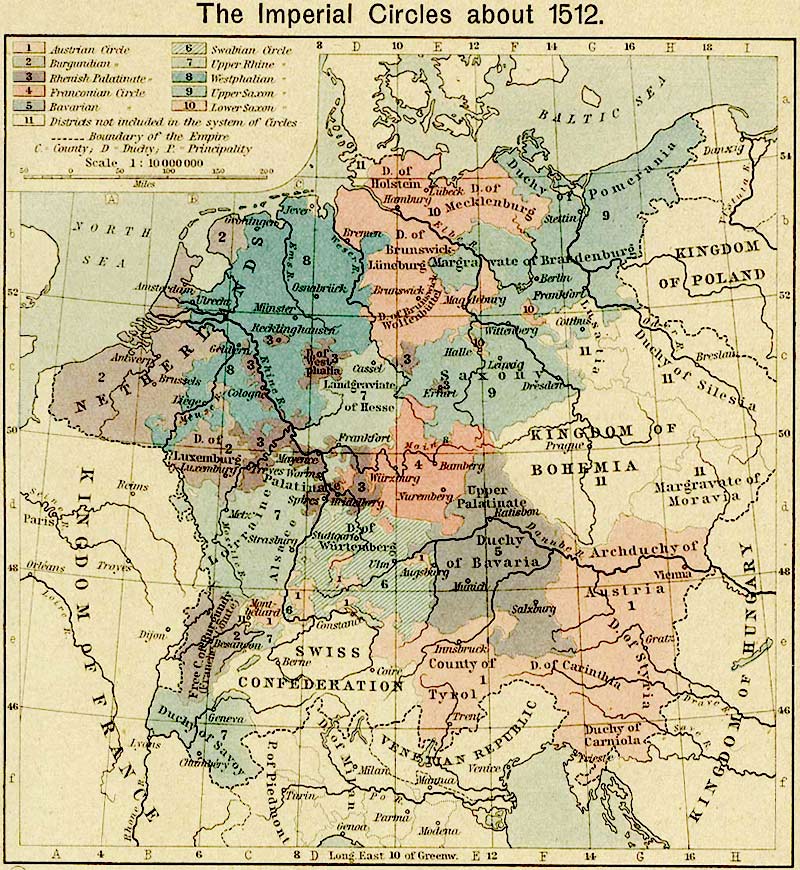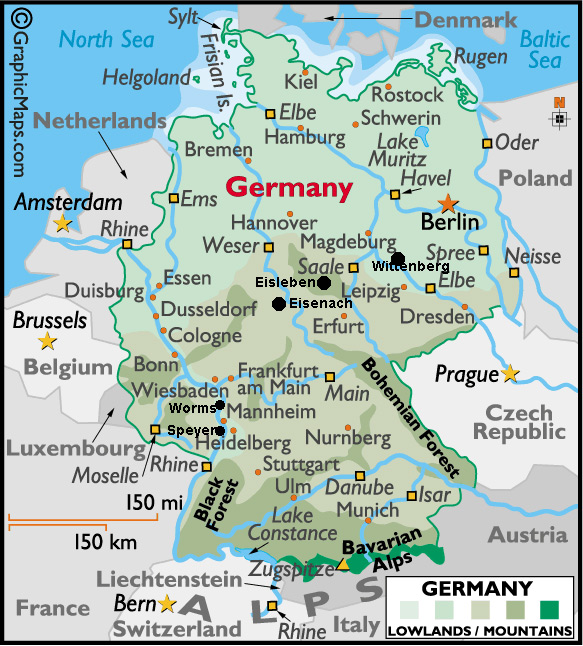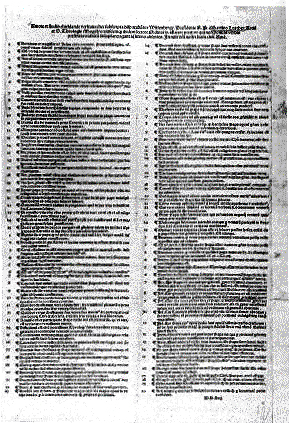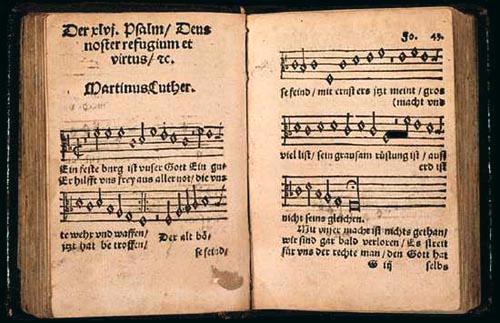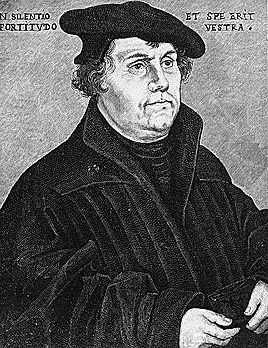Martin Luther was born 10 Nov, 1483 in Eisleben, Germany and moved with his family to Mansfield the following year. After 8 years of school there, he spent one year at a school founded by the Brethren of the Common Life in Magdeburg. He then spent four formative years in Eisenach, where he had been sent to study. As a young student there, Luther earned money to pay his school fees by singing in the streets of Eisenach. Luther played the lute, and singing always was an important part of his life.
In 1501, he entered the University of Erfurt, with a view to studying law at the request of his father. He earned a degree in 1505, started studying law, but dropped out after half a year. Either after the death of a friend or after being caught in a terrible thunderstorm he entered the Augustinian monastery at Erfurt. As a novitiate he began to read the Bible, which he had not done previously. He was ordained into the priesthood in 1507 and during the winter of 1508-09 he was sent to the University of Wittenberg. After one year, he went back to Erfurt and earned his Doctorate in theology. He was sent on a mission to Rome in 1510 or 1511, where he was exposed to some of the excesses of the Catholic Church and the worldliness of the Italian clergy.
In 1512, he went back to Wittenberg, where he had a “conversion” in his tower cell while studying Romans 1:17: “The righteous shall live by faith.” The phrase "the righteousness of God" like most Biblical terms (e.g., grace, faith, justification, etc.) had been reinterpreted by scholastic theologians of the high and late Middle Ages to support a theology of Law and works. For centuries the Church had taught that the righteousness of God was God's active, personal righteousness or justice by which he punishes the unrighteous sinner. On reading Romans 1:17 again, Luther realized that the phrase meant not the active righteousness that God demands, but the passive righteousness that He freely gives to those who believe the Gospel. The sinner is justified (declared righteous) by God through faith in the work and death of Jesus, not by our work or keeping of the Law. Put another way, the sinner is justified by receiving (faith) rather than achieving (works). Sola Fide, or "Faith Alone", became the watchword of the Reformation.
In 1517 Luther posted his 95 theses, under the title “Disputation of Doctor Martin Luther on the Power and Efficacy of Indulgences.” Some sample statements are:
1.Our Lord and Master Jesus Christ in saying: "Repent ye" [lit.: Do penance, poenitentiam agite], etc., intended that the whole life of believers should be penitence [poenitentiam]
4. The penalty [poena] thus continues as long as the hatred of self—that is, true inward penitence [poenitentia vera intus]—continues; namely, till our entrance into the kingdom of heaven.
5. The Pope has neither the will nor the power to remit any penalties, except those which he has imposed by his own authority, or by that of the canons.
50. Christians should be taught, that, if the Pope were acquainted with the exactions of the preachers of pardons, he would prefer that the Basilica of St. Peter should be burnt to ashes, than that it should be built up with the skin, flesh, and bones of his sheep.
62: The true treasury of the church is the holy gospel of the glory and the grace of God."
In the "Explanations of the 95 Theses" published in early 1518, Luther demonstrates the difference between the two words when he wrote: "By recovery of one's sense, it happens that the sinner has a change of heart and hates his sin." Following this discovery, repentance for Luther could no longer designate a work that is done and completed within a sacramental ritual. It was, rather, a lifelong movement or struggle with one's sin.
In 1518 Luther met a student, Philipp Melanchthon, who became a great scholar and reformer in his own right. His scholarship and theological reflection complemented Luther's background.
In 1518 Luther was summoned to Rome, where he probably would have been executed as a heretic. Frederick the Wise (Elector Palatine and King of Bohemia) intervened and Luther was allowed to appear before the Diet in Augsburg to demand that he recant. The pope issued a bull (an edict) pronouncing the statements in the theses heretical. Luther promised not to speak about them any more but the next year he became involved in a debate on the supremacy of the Catholic church.
The 1519 Leipzig debate with Johann Eck centered on John Hus and papal supremacy. Luther took the side of Hus, who had been condemned as a heretic by the Council of Constance. In this debate, Eck charged Martin Luther with being a Hussite because Luther appealed to the supreme authority of Scripture. Luther was not sure about this, but spent the noon break reading what Hus had written. At the beginning of the afternoon session he surprised everyone by loudly proclaiming: "Ich ben ein Hussite!"
In 1520 Luther published “On Good Works” and on June 15, Pope Leo signed a bull excommunicating Luther and requiring his followers to recant on penalty of imprisonment. Luther was not allowed to preach, and his books and writings were to be burned. Luther published “Against the Execrable Bull of Antichrist” and three great reformation treatises: “To the Christian Nobility of Germany”, “The Babylonian Captivity of the Church”, and “The Liberty of a Christian Man.” On December 10, Luther burned the papal bull and books of the canon (Church) law. “As thou hast wasted the Holy One of God, so may the eternal flames waste thee.”
In 1521 the Pope had exhaused his ecclesiastical means of punishing Luther, so he turned to secular means. Charles V had become Holy Roman Emporer in 1519 and Pope Leo appealed to him and prevailed on him to send Luther to appear before the Diet at Worms. Here he had to appear before the Emperor twice; each time he was clearly told to take back his teachings. Luther didn't see any proof against his theses or views which would move him to recant: "Unless I am convinced by Scripture and plain reason - I do not accept the authority of the popes and councils, for they have contradicted each other - my conscience is captive to the Word of God. I cannot and I will not recant anything for to go against conscience is neither right nor safe. God help me. Amen." The infamous saying "Here I stand. I cannot do otherwise." does not come from Luther.
Frederick allowed Luther to be “kidnapped” and he was carried off to Wartburg castle, where he remained for 10 months, writing. During this time he translated the New Testament into German, using the recent 1516 critical Greek edition of Erasmus.
In 1525 Luther married Catherine Van Bora, who had been a nun.
Later there were two Diets at Speyer. The first in 1526 decided that the Edict of Worms would not be enforced and each Prince could decide if Lutheran teachings and worship would be allowed in his territories. The second in 1529 reversed this policy. This was opposed by members that supported Lutheran teachings and practices, who vigorously protested the decision. Their action created the term Protestantism, still used today as a name for this religious movement.
In 1529 he wrote the Shorter catechism and in 1530 the Larger Catechism. In 1530, he and Melanchton published the Augsburg Confession which became the theological statement of the church. Luther's Old Testament was completed in 1534. During times when the Reformation seemed lost, Luther would say to his friend Melanchthon, "Let's sing the Forty-sixth Psalm." "A Mighty Fortress" draws its inspiration from Psalm 46. Listen to a 1535 version or a
version from the Strassburg hymnbook of 1616.
Luther wrote at least 35 other hymns.
Effects of the Reformation:
Changed the church's theology and liturgy:
Sola Fide, Sola Scriptura, Sola Gratia, Solus Christus, Soli Deo Gloria, priesthood of believers, congregational singing, no worship of images, veneration of relics, holy water, purgatory, denial of transubstantiation.
Changed church government-no bishops or pope, more congregational
New materials for study and worship
-Bible, catechism, hymnbook, Augsburg confession
Footnotes and Graphics
